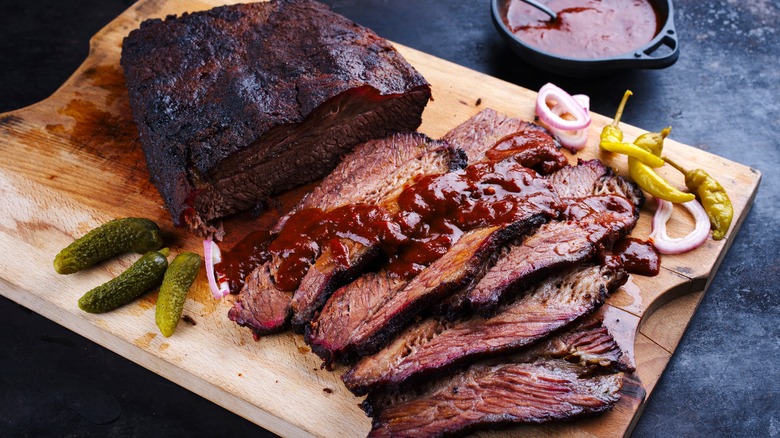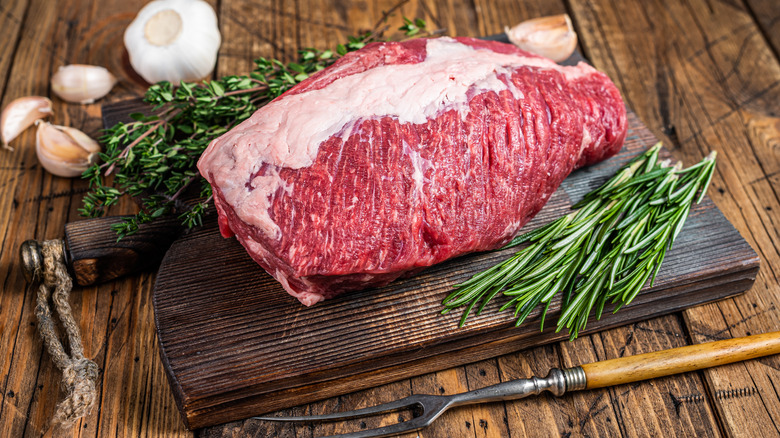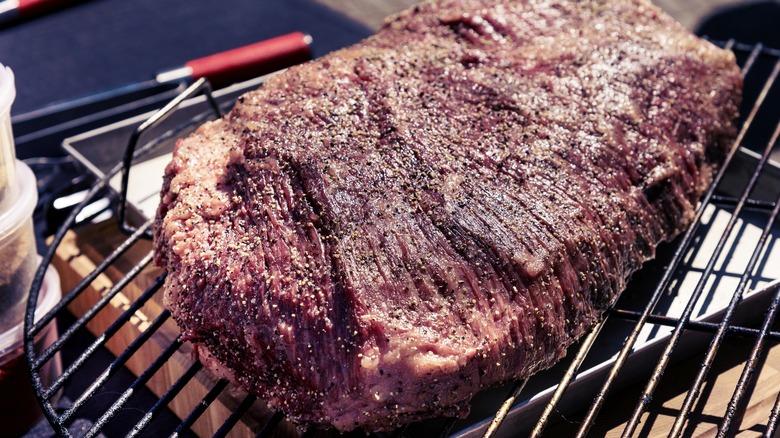When Aging A Brisket At Home, Don't Make This Mistake With Your Fridge
While there's a ton of options for exactly what you decide to smoke, it's brisket that presents the ultimate challenge to pitmasters of all levels. Why? It tends to be a large cut from muscles that work hard during the cow's life, and that means that it can very easily get tough. Aging your meatbefore smoking it is one way to help make sure that the long hours required to smoke a brisket aren't going to go waste, and the final product is tender.
Just how long should you age a brisket? That's a complicated question with a lot of different answers, but generally, it's recommended that brisket is allowed to age for somewhere between 21 and 45 days. Some sources will recommend letting it go for as long as 60 days, but add that if you go beyond that, you're risking letting it go too far and developing spoilage that will ruin the meat more than toughness can. While there is some wiggle room in deciding the duration, it's important to note exactly when the aging process starts — especially if you're aiming for the upper end of the scale.
Don't make the mistake of aging from the day you put the brisket in your fridge, as the process starts from the day it was packed. When you're marking your calendar to keep track of the days — and you are marking your calendar, right? — it's crucial that you use the packing date.
Here's why the aging process is so important
A few things that happen when you allow a brisket to age instead of smoking it when it's fresh from the store. Brisket comes from an area of the cow that's worked a lot, and here's a fun fact: The word "brisket" actually refers to the part of the cow the cut comes from, which is the lower chest — or "breast" — area. Because it's exercised as the cow walks, it's a fatty piece of meat that has a lot of connective tissue, or collagen. Cooking it low and slow is one way to get that tough tissue to break down into a tender piece of meat, and aging it also helps the tenderizing process. As meat is left to age, there's a chemical process that goes on inside the meat. Enzymes break down protein structure, and those proteins are what hold that tough connective tissue in place.
Once the connective structures in the meat start to break down, that essentially loosens the meat to a point where as it cooks, it's not going to constrict and lose as much moisture. That'll make it more juicy and more tender, and there's another part to this. Due to the aging process, a greater amount of collagen turns to gelatin when cooked, adding moisture to the brisket. The result is a mouth-watering meal instead of a shoe that even Charlie Chaplin would struggle with.
Beware of telltale signs that aging has gone wrong
Along with ensuring you don't make the mistake of aging based on the day you bring your meat home instead of from the day it was packaged, there are some other things to keep in mind during the process. When you pull your aged brisket out of the fridge to get it ready for the smoker, it's going to look a little different. While freshly packed brisket has a bright red color, aged brisket is likely to turn a deep purple. That's because myoglobin — which gives meat that bright color — changes when it's exposed to oxygen over time, which will happen in the refrigerator. It's still perfectly fine.
If you happen to go a few days over or under your aging window, that's no reason to think that your brisket is going to be ruined. There are, however, a few things you should look for when you're getting aged meat ready. The bag that the meat is stored in shouldn't show signs that it's inflating, as that means there's something growing in the meat that shouldn't be. A purple color is fine, but green indicates mold. You should also smell the brisket: It won't smell fresh, but meat with a rancid or rotten odor is a problem. If you don't want to handle it when it's raw, you're not going to want to eat it when it's cooked. Stick to the safe, tried-and-true time frame, and you're good to go.


